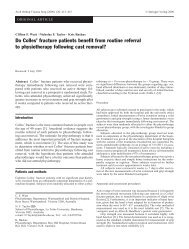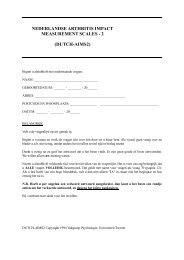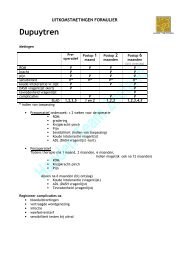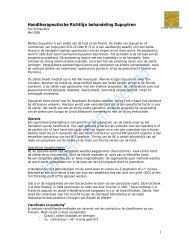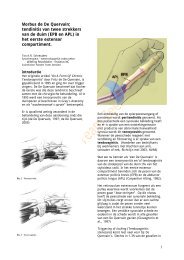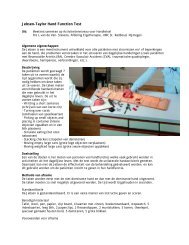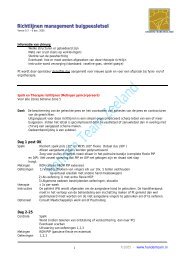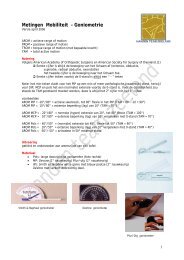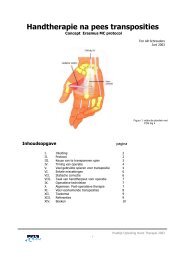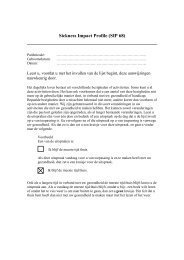Muscle strength measurements of the Hand - Handen Team Zeeland
Muscle strength measurements of the Hand - Handen Team Zeeland
Muscle strength measurements of the Hand - Handen Team Zeeland
Create successful ePaper yourself
Turn your PDF publications into a flip-book with our unique Google optimized e-Paper software.
Ton A.R. Schreuders, JW Brandsma, HJ Stam<br />
FIGURE 5. Prevention <strong>of</strong> IP flexion<br />
contractures by massaging <strong>the</strong> fingers.<br />
Exercises to <strong>strength</strong>en <strong>the</strong><br />
interossei muscles are all aimed at<br />
movements which flex <strong>the</strong> MCP and<br />
extend <strong>the</strong> IP joints. Therefore, exercises<br />
for <strong>the</strong> interossei muscles are all activities<br />
in intrinsic plus position: e.g. grasping a<br />
book, plate or a cylindrical object like a<br />
large bottle. Specific training <strong>of</strong> <strong>the</strong> first<br />
dorsal and palmar interossei are activities<br />
for which key and tip pinch activities are<br />
required.<br />
To correct <strong>the</strong> long flexor tightness,<br />
<strong>the</strong> patient is taught to stretch <strong>the</strong> flexors<br />
by holding <strong>the</strong> hand flat on e.g. a table and<br />
by moving <strong>the</strong> forearm towards an angle<br />
perpendicular to <strong>the</strong> table. In a similar<br />
fashion, <strong>the</strong> hand can be placed on <strong>the</strong><br />
seat <strong>of</strong> <strong>the</strong> chair while <strong>the</strong> patient sits on<br />
<strong>the</strong> hand and pulls <strong>the</strong> forearm towards<br />
<strong>the</strong> body. A night splint with <strong>the</strong> fingers<br />
and hand in extension might be necessary<br />
in severe cases.<br />
1.2 Lumbricals<br />
1.2.1 Functional anatomy<br />
The lumbrical muscles are unique<br />
muscles in several aspects. They connect<br />
two extrinsic antagonistic muscles.<br />
Proximally <strong>the</strong> lumbricals are attached to<br />
<strong>the</strong> FDP and distally <strong>the</strong>y are inserted into<br />
<strong>the</strong> lateral band <strong>of</strong> <strong>the</strong> extensor tendon.<br />
The third and fourth lumbricals also<br />
connect, by <strong>the</strong>ir bi-penal origin, two<br />
adjacent FDP tendons.<br />
The function <strong>of</strong> <strong>the</strong> lumbrical<br />
muscles is much debated and some even<br />
considered <strong>the</strong>se muscles to be<br />
redundant. Brand suggested that <strong>the</strong><br />
lumbrical muscles are not relevant for<br />
MCP flexion. He explained this with an<br />
illustration <strong>of</strong> a fa<strong>the</strong>r carrying a child; it<br />
does not matter what <strong>the</strong> child (i.e.<br />
lumbrical) is carrying, <strong>the</strong> fa<strong>the</strong>r (i.e. FDP)<br />
has to carry it anyway. 4 Therefore, <strong>the</strong><br />
lumbrical muscles have a unique ability to<br />
contract without adding flexion torque at<br />
<strong>the</strong> MCP joint, in contrast with <strong>the</strong><br />
interosseous muscles which, when<br />
extending <strong>the</strong> IPs, need a stronger<br />
contraction <strong>of</strong> <strong>the</strong> EDC to counteract <strong>the</strong><br />
flexion moment at <strong>the</strong> MCP joint level. The<br />
lumbricals provide a more efficient source<br />
for IP extension than <strong>the</strong> interossei.<br />
Any contraction <strong>of</strong> <strong>the</strong> lumbrical<br />
muscle for IP extension simultaneously,<br />
reduces <strong>the</strong> visco-elastic force <strong>of</strong> <strong>the</strong> FDP<br />
tending to flex <strong>the</strong> IP joints. Accordingly<br />
<strong>the</strong> lumbrical can be regarded as a<br />
deflexor <strong>of</strong> <strong>the</strong> PIP joint. 57 Its direct<br />
contribution to MCP flexion is small and in<br />
<strong>the</strong> flexed finger may be non-existent, but<br />
its indirect contribution to IP joint extension<br />
by decreasing <strong>the</strong> flexion torque is quite<br />
substantial. 58<br />
With <strong>the</strong> smallest physiological<br />
cross-sectional area, it is certainly not a<br />
strong muscle. The lumbricals have a very<br />
long fiber length (40-48 mm) which<br />
indicates that <strong>the</strong>y are designed for long<br />
excursions. If <strong>the</strong> lumbrical fiber length<br />
was short, FDP excursion could stretch<br />
<strong>the</strong> lumbrical sarcomeres to a point that<br />
<strong>the</strong>y were unable to generate active<br />
force. 33<br />
The lumbrical muscles are richly<br />
endowed with muscle spindles, <strong>the</strong>ir<br />
passive stretch by contraction <strong>of</strong> <strong>the</strong> FDP<br />
might both inhibit finger extensors and<br />
facilitate wrist extensors. 58-61 For this<br />
reason <strong>the</strong> lumbrical muscles have been<br />
called “tensiometers” between long flexors<br />
and extensors. 62 Leijnse and Kalker 46<br />
concluded that <strong>the</strong> lumbricals are in an<br />
optimal position for proprioceptic feedback<br />
concerning <strong>the</strong> PIP-DIP joint mechanism.<br />
These unique properties <strong>of</strong> <strong>the</strong><br />
lumbricals indicate that <strong>the</strong>y are probably<br />
important in fast, alternating movements,<br />
e.g. in typing and playing musical<br />
instruments. 63<br />
10



